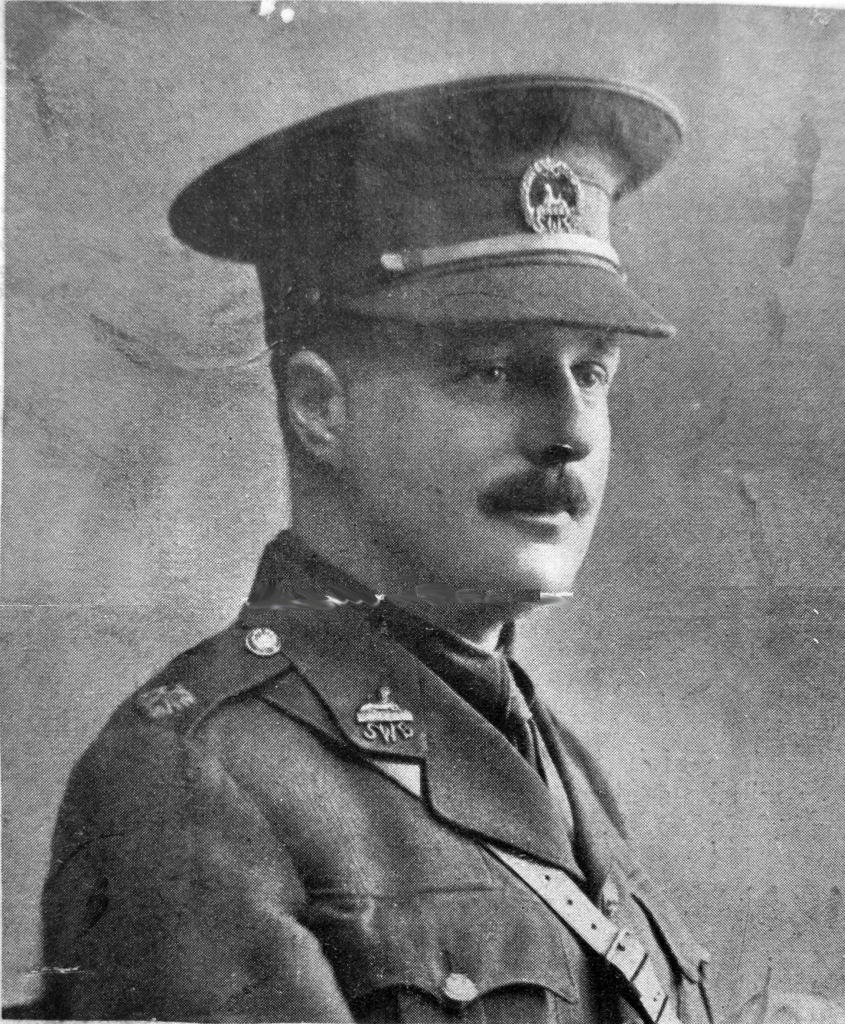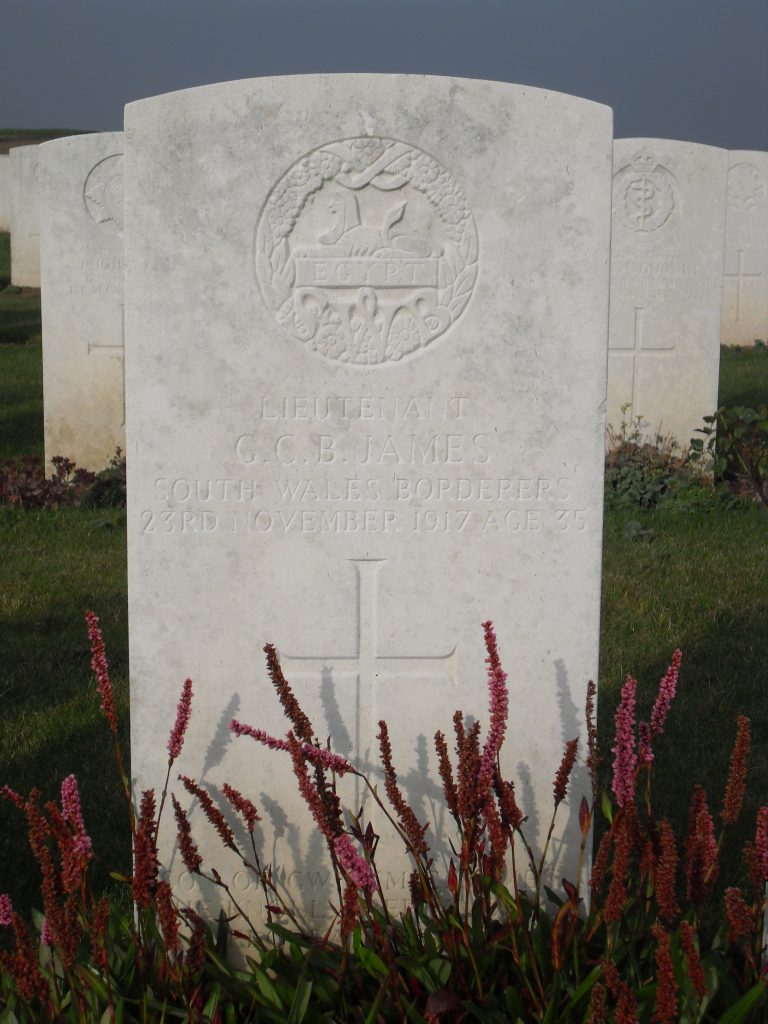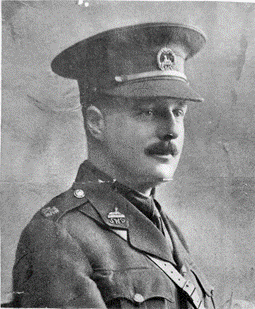Fact file:
Matriculated: 1902
Born: 28 August 1883
Died: 23 November 1917
Regiment: South Wales Borderers
Grave/Memorial: Rocquigny-Equancourt Road British Cemy,Manancourt; Grave IV.B.9.
Family background
b. 28 August 1883 as the younger son (youngest of four children) of Gwilym Evelyn C(h)ristor James, JP, DL (1849–1925) and Elizabeth Margaret James (née Rees) (1849–1921) (m. 1873). At the time of the 1891 Census, the family was living at Gwaelodygarth House, Merthyr Tydfil (five servants); at the time of the 1901 Census they were still living at the same address (three servants), and again at the time of the 1911 Census (four servants and a nurse); but at the time of James’s death the family was living at Llan Wysg, Crickhowell, Breconshire.
Parents and antecedents
James’s father was a solicitor in the family firm (Gwilym James, Charles & Davies of Merthyr Tydfil), which had been largely built up by James’s grandfather, Charles Herbert James (1817–90), who became a solicitor in 1838. Charles Herbert had been active in the civic life of Merthyr Tydfil, the chairman of its Science and Art Committee, and an enthusiastic supporter of its library. He was brought up a Wesleyan, but later became a Unitarian and President of the Unitarian Association, and he served as the town’s Liberal MP (1880–88). By 1901, James’s father had become a JP on the Monmouth bench and from 1914 to 1915 he served as High Sheriff of Breconshire. Charles Herbert’s wife, Sarah Thomas (1817–91), i.e. James’s paternal grandmother, was the sister of President Warren’s mother, making Warren first cousin of James’s father. Charles Herbert was the cousin of Sir William Milbourne James (1807–81), who also came from Merthyr Tydfil and was an important legal figure in the mid-nineteenth century, rising to the rank of Lord Justice of Appeal and Privy Councillor.
James’s maternal grandfather was John Rees JP (1816–84) a draper of Aberystwyth, who had a governess for his two daughters. He was a long-serving member of the Aberystwyth Town Council, Board of Guardians and Burial Board. He was active locally as a Liberal helping to secure the return of Liberal candidates for the county of Cardigan.
Siblings and their families
Brother of:
(1) Gertrud Elizabeth Sarah (1874–1946); later Hankey after her marriage in 1905 to Norman Frederick Hankey (1865–1935); two daughters;
(2) Dora Eveline (1876–1967); later Evans after her marriage in 1898 to Evan David Evans (1876–1936); one daughter;
(3) Rees Herbert (b. 1880, d. 1924 in Wellington, New Zealand); married (1918) Annie Marie Fitzhowell-Jones (probably born in Wellington, New Zealand).
In 1901, Norman Frederick Hankey, who had been an Exhibitioner in Modern History at Magdalen from 1884 to 1888 (BA November 1889), was the Managing Director of Hill’s Plymouth Colliery, a name which at one time applied to all the pits and levels that were worked by the Plymouth Iron Company to supply their works. They were situated two to three miles south of Merthyr Tydfil in an area that extended from a point north of Pentrebach to Troedyrhiw. In 1862, the Plymouth Iron Works was sold to Fothergill, Hankey and Bateman. From 1916 to 1918, Norman Hankey was Mayor of Merthyr Tydfil, and when the Hankeys’ elder daughter was married in 1927, the ceremony was attended by the Conservative politician Stanley Baldwin (1867–1947), Prime Minister from 1923–24 and 1924–31.
Evan David Evans was the son of Christmas Evans (1838–1909), who was the proprietor of the Six Bells Brewery, Heolgerrig, and chairman of the Britannic Merthyr Coal Co. Ltd.
Rees Herbert was at one time a stockbroker in London, but moved to New Zealand. This move was precipitated by an unfortunate love affair, which was discussed in several newspapers at the time. In January 1907 he was charged with having threatened the life of Ruth Cole, daughter of Alan Cole, CB, Assistant Secretary at the Board of Education. The two had been engaged but she had broken it off on the advice of her family because of his behaviour – heavy drinking. It was alleged that at Prince’s Skating Rink he threatened to shoot her if she became engaged to anyone else and he reiterated this threat in a telegram he sent her on Christmas Eve 1906. He was remanded in custody. At his second appearance he retracted the comments he had made on his first appearance (not reported) and Mr Marshall Hall, KC, for the prosecution said “it was one of those cases he felt in which the less said the better”. He was ordered to find surety for his good behaviour and he promised to go abroad for two years.
Education and professional life
James attended Temple Grove Preparatory School, near Richmond Park, East Sheen, Surrey, from c.1890 to 1896 (it was one of the oldest English preparatory schools and one of the top five preparatory schools in England in the nineteenth century, which has been called “the cradle of Empire”; founded 1818, moved to Eastbourne, Sussex, 1907). He was then at Eton from 1896 to 1901, where he became Captain of Mr Hare’s House, Captain of Lower Boy Football, and Captain of the Games (White House and Jordley’s Place). He also rowed in the Eton VIII at the Henley Regatta on several occasions. After his death, the Eton Chronicle described him as “strong, just, and always cheery”, and as someone who “did his utmost to inspire the House”, was “invaluable in the House” and who could be “trusted absolutely: invaluable in imparting energy to others”. He matriculated at Magdalen as a Commoner on 24 January 1902, having passed Responsions in Michaelmas Term 1901. He took the First Public Examination in the Hilary and Trinity Terms of 1903 with Classics as an Additional Subject, and was awarded a 3rd in Jurisprudence in Trinity Term 1905. He took his degree on 10 August 1905.

Gwilym Christopher Bowring James, BA (detail from a picture of Magdalen’s 1st VIII, 1905)
(Photograph courtesy of Magdalen College, Oxford)
While at Magdalen, James rowed with V. Fleming in the Oxford University Boat Club (OUBC) IVs in 1902 and also in the OUBC Trial VIIIs, but he never made it into the Blue Boat. In 1903, he and Fleming rowed in the Magdalen VIII that came Second on the River in Oxford and won the Ladies’ Challenge Cup at Henley that summer for the first and only time: the same VIII also tried for the Visitors’ Challenge Cup but lost. In summer 1904 they remained Second on the River, and in the same year James rowed for a losing crew in the OUBC IVs. In summer 1905, when he was Captain of the Magdalen College Boat Club, he rowed together with L.R.A. Gatehouse and E.H.L. Southwell in the VIII which started Second on the River, went Head on the first night by bumping New College, and then, for four nights, successfully held off University College, which had bumped New College on the second night. Consequently, he would have taken part with considerable gusto in the bacchanalian Bump Supper on 31 May 1905 that is described by G.M.R. Turbutt. He was elected a member of Leander.
At Magdalen as at Eton “Jimmy” James […] was deservedly popular. Sensible, good-natured, almost too modest, certainly not pushing, cheery, jolly, and good-looking, he made as many friends as he wanted and as many enemies – that is none at all – and when his three years came to an end he was genuinely missed.
After leaving Oxford, James trained as a solicitor and passed the Law Society Final Examination in November 1908. He then went back to Wales to work in the family firm, of which he had become the Senior Partner and “rising hope” by the outbreak of war. Although both James’s parents were bilingual (Welsh and English), their children grew up speaking only English. But after his return to Wales, James learnt Welsh and, although a keen sportsman, allowed himself “only moderate indulgence in the hunting with the Gelligaer hounds, and the rowing which he loved”.

The Merthyr Volunteers in 1907. James is seated second from the left in the second row. Seated beside him, third from left, is Lieutenant Harry Hartley Waite Southey (1871–1917), who was also killed in the First World War.
(Courtesy of Cyfarthfa Castle Museum and Art Gallery)
Military and war service
From 1905 to 1909 James was a subaltern in the 1/5th Battalion (Territorial Force), the Welsh Regiment, but resigned his commission on 18 October 1909 because of the pressure of work. When war broke out, James could still not be spared from the family firm and was reluctantly forced to stay at home. But on 6 September 1916 he joined No. 3 Company of the Inns of Court Officers’ Training Corps (“The Devil’s Own”), and then, on 26 November 1916, he was sent on a month’s course with No. 14 Officer Cadet Battalion at Berkhamsted, Hertfordshire, where he trained with the 3rd (Reserve) Battalion of the South Wales Borderers. After spending a short time with the same Battalion near Liverpool, he was attached to the Regiment’s 2nd (Regular) Battalion, i.e. the Battalion that was largely massacred at the Battle of Isandlwana on 22 January 1879 and then distinguished itself at the Battle of Rorke’s Drift on the following day. The 2nd Battalion was also the only British unit to take part in the Japanese-led siege of the German naval base and colony (since 1898) of Tsingtao (552 square metres, now Qingdao, China) from 31 October until 7 November 1914.

Gwilym Christopher Bowring James, BA (1915/16)
(Photograph courtesy of Magdalen College, Oxford)
The 2nd Battalion had returned from China to Plymouth on 12 January 1915, landed on the island of Mudros on 11 April 1915, and served with distinction in the Gallipoli campaign from 25 April until 11 January 1916 (cf. J.H. Harford). It arrived at Marseilles on 15 March 1916 as part of 87th Brigade, 29th Division, and then took very heavy casualties on the Somme (cf. Harford). So from then until 7 October 1916 it reformed and trained near Poperinghe, in the Ypres Salient, and arrived on the Somme at Cardonnette, north-east of Amiens, on 10 October. It then took part in the final phases of the Battle of the Somme around Gueudecourt, during which Harford was killed in action on 26 October 1916. After that the Battalion stayed in the area to the east of Arras until late April 1917 and was involved in the Second Battle of the Scarpe (23/24 April 1917), which cost it nine officers and 228 other ranks (ORs) killed, wounded or missing. The push eastwards past Bullecourt on 19 May (see P.W. Beresford) cost the Battalion a further three officers and 76 ORs killed, wounded or missing and reduced it to an effective strength of 20 officers and 502 ORs.
James, now a Lieutenant, went to France in spring 1917 and joined the Battalion’s ‘D’ Company on 11 June 1917 while it was in billets at Candas, a few miles to the south-west of Doullens, and training in the Autheux Training Area, just to the north. At 34, James was old for a subaltern, and in a letter that he wrote home from France, he said: “They call me ‘father’ out here, but I’ll show them that there is life in the old dog yet.” On 27 June 1917 the Battalion was moved northwards to the Poperinghe area, and from 2 to 6 July it spent four quiet days in the trenches on the Canal Bank, to the east of Ypres. By 31 July the Battalion’s strength stood at 33 officers and 829 ORs, who were training for the coming offensive in various camps.
On 15 August the Battalion prepared for the attack, and at 04.45 hours on the following day the phase of the Third Battle of Ypres (31 July–10 November 1917) that became known as the First Battle of Langemarck (16–20 August 1917) began. The attack was badly planned; the British did not enjoy artillery superiority; the available troops had not been concentrated opposite the Gheluvelt Plateau, which should have been the key objective; and the mud hampered the attack, not least by preventing the use of tanks. I French Corps was on the left of the line, with the 29th and 20th British Divisions between them and James’s Battalion. They attacked along the Ypres–Staden railway line and the River Steenbeek, and the 20th Division captured the fortified village of Langemarck. But they suffered disproportionately heavy casualties in return, with James’s Battalion alone taking over 500 casualties, including seven officers, one of whom was James’s Company Commander, Captain Willie Ross (1879–1917), who had been raised from the ranks. After that, the Battalion spent most of September training in camps behind the lines and did not return to the trenches until 30 September, i.e. during that phase of Third Ypres that is known as the Battle of Polygon Wood (26 September–3 October 1917). It then spent five days in the trenches near Langemarck, lost two more officers and 47 ORs killed, wounded or missing, left the Ypres Salient, and spent the following six weeks training mainly at Bellacourt, seven miles south-west of Arras.
On 17 November 1917, the Battalion entrained for Péronne and marched on arrival north-eastwards to the village of Fins (19 November). On the following day it marched a further two miles to the assembly area at Gouzeaucourt and thence another three miles northwards to Marcoing, fives miles to the south-south-west of Cambrai, where it was in position by dawn on 21 November. The advance eastwards on Masnières began at noon and the fighting continued until 30 November. But before the Battalion’s leading line had gone 200 yards, it was enfiladed on two sides by very heavy machine-gun fire which swept the slope on the 2nd Battalion’s right and left front. There was very little cover and the two or three tanks that had been sent in support were of little help. James was badly wounded and died of wounds received in action on 23 November 1917, aged 35, in No. 21 Casualty Clearing Station, Ytres, ten miles south-west of Cambrai, one of the Battalion’s 223 officers and ORs who were killed, wounded or missing as a result of the engagement. He is buried in Rocquigny-Equancourt Road British Cemetery, Manancourt, Grave IV.B.9, with the inscription: “Son of Gwilym James, The Knoll, Abergavenny. Floreat Etona” (“Long may Eton flourish”). His obituary in the Eton Chronicle characterized him as follows: “Whatever he did, he did it with his might, working as strenuously as he played: big-hearted and glad-hearted, he best illustrated true manliness not only on the field of battle, but in every hour of his life.”

Rocquigny–Equancourt Road British Cemetery, Manancourt; Grave IV.B.9
On 3 December 1917, James’s father, signing himself Evelyn James, wrote a letter to President Warren in which he painted a very high-minded picture of his son:
Christie’s whole life was a noble one I am glad to say. He never gave me or his Mother a moment’s anxiety. As soon as the Junior Partner of the Firm was invalided out of the Army & discharged[,] Christie thought it his duty to join up and put himself at his Country’s service – One of the outstanding features of Christie’s life was his intense love for humanity – A few weeks ago he wrote to me to say that it had been suggested to him by his Superior Officers that he would be a very fitting person to take over a School of Instruction at the base. – His answer was most characteristic[;] he said he had gone through much with his men, that he understood them, respected them and knew their capabilities and wished to be with them to the end and so he stuck to his post manfully and fell by their side like the noble boy he was.
And on 26 January 1918, angered by the unrest among the Welsh miners and their demands for higher pay when they were already among the highest paid of Britain’s manual labourers and working in far less dangerous conditions than their contemporaries at the front, James’s father wrote a second letter to Warren in which he said, with some bitterness that was shared by many people in Britain at the time:
One third of the men in the collieries in South Wales could be spared for the Army and the output could be maintained by the remaining two thirds. I am satisfied that the country is not even yet making the sacrifices it should make.
James left £4,415 3s. 2d.
Bibliography
For the books and archives referred to here in short form, refer to the Slow Dusk Bibliography and Archival Sources.
Printed sources:
[Anon.], ‘A Stockbroker’s Love Story; A curious case at Westminster’, Pall Mall Gazette, no. 13,023 (7 January 1907), p. 8.
[Anon.], ‘A Stockbroker’s Love Story’, Pall Mall Gazette, no. 13,029 (12 January 1907), p. 8.
[Anon.], ‘Lieutenant G.C.B. James’ [obituary], The Times, no. 41,650 (1 December 1917), p. 11.
[Thomas] H[erbert] W[arren], ‘Oxford’s Sacrifice’, The Oxford Magazine, 36, no. 8 (7 December 1917), p. 113.
[Anon.], ‘G.C.B. James’ [obituary], The Eton College Chronicle, no. 1,639 (31 January 1918), p. 348.
Errington (1922), p. 215.
Leinster-Mackay (1984), pp. 4, 23–5, 30–31, 40–8, 54, 58–9, 91, 126, 135.
Steel and Hart (2001), pp. 145–6.
Archival sources:
MCA: 02/1/P6/45 (Photograph of Magdalen’s 1st VIII [1905]).
MCA: PR32/C/3/713-715 (President Warren’s War-Time Correspondence, Letters relating to G.C.B. James [1917–18]).
MCA: Ms. 876 (III), vol. 2.
OUA: UR 2/1/45.
OUA (DWM): C.C.J. Webb, Diaries, MS. Eng. misc. e. 1162.
WO95/2304/2.
